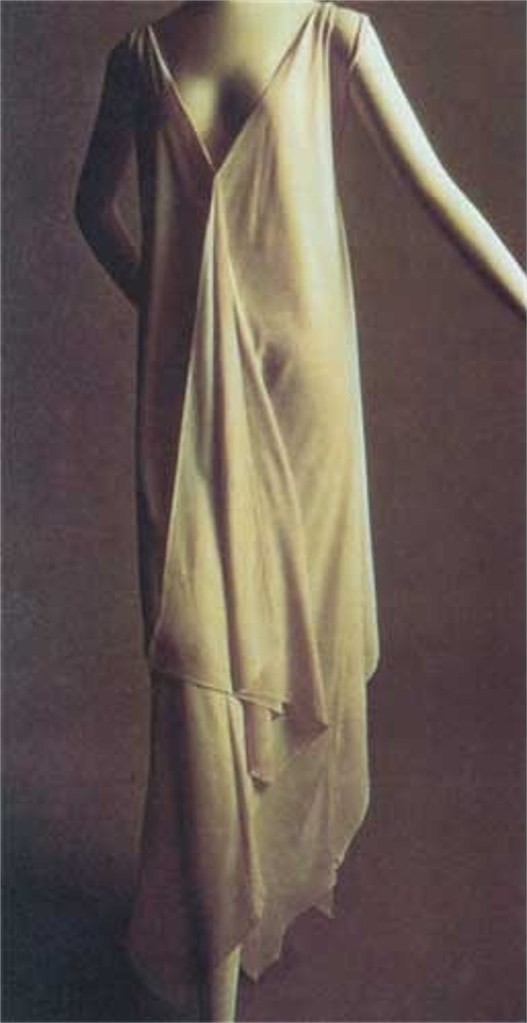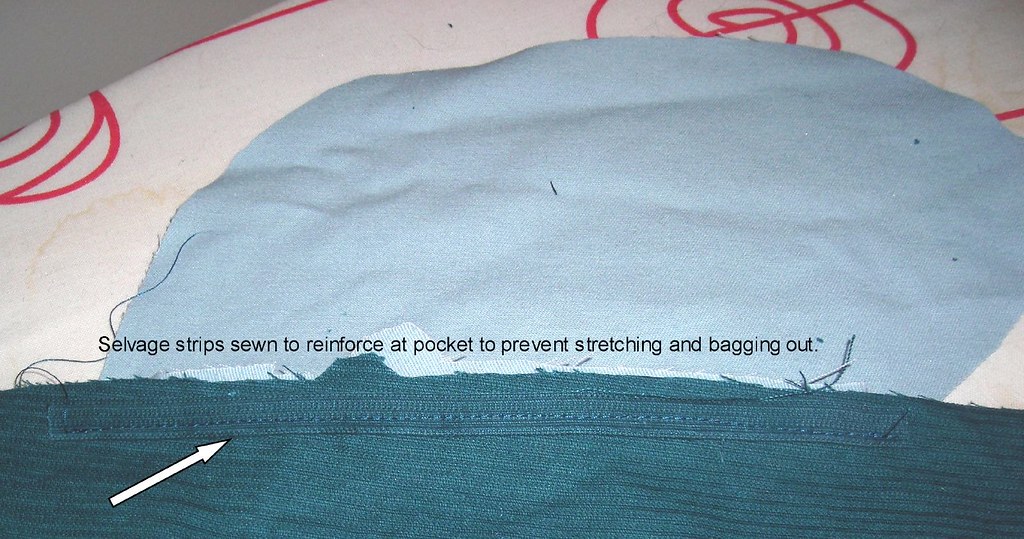Grain: The grain of fabric runs down the length of it.
Crossgrain: The crossgrain runs along the width of the fabric. Most fabric manufactured for home sewing is 44, 45, 58, or 60 inches wide. For simplicity, usually fabric is referred to as either 45 or 60 inches wide, regardless of actual width (as long as actual width is within a few inches). Patterns will tell you how much fabric you need for both 45 and 60 widths, There is an exception for patterns that give the length needed for only for 60 wide; these patterns have large pieces that won't fit on 45 wide and you must look for 60 wide fabric. Some bridal and home dec fabrics are manufactured in 108 inch widths.
 Bias: The bias runs at a 45 degree angle to the grain. Cutting fabric on the bias gives a bit of stretch to woven fabrics and results in a garment that skims the body beautifully. Madeleine Vionnet (see photo at right, and if you want more visit this fantastic article) debuted the use of bias on a large scale in the 1920s. It requires care not to stretch the fabric during construction. Generally, you should staystitch any piece cut on the bias immediately after cutting it. Even on garments cut on the grain, staystitching is usually recommended for necklines, because the curved neckline is partly on the bias and can get stretched out of shape. Bias stretches unevenly, so items made on the bias have to hang for at least 24 hours to allow the hem to stretch; the hem is then cut off even and sewn. I'm not going to lie to you, I am intimidated by bias projects.
Bias: The bias runs at a 45 degree angle to the grain. Cutting fabric on the bias gives a bit of stretch to woven fabrics and results in a garment that skims the body beautifully. Madeleine Vionnet (see photo at right, and if you want more visit this fantastic article) debuted the use of bias on a large scale in the 1920s. It requires care not to stretch the fabric during construction. Generally, you should staystitch any piece cut on the bias immediately after cutting it. Even on garments cut on the grain, staystitching is usually recommended for necklines, because the curved neckline is partly on the bias and can get stretched out of shape. Bias stretches unevenly, so items made on the bias have to hang for at least 24 hours to allow the hem to stretch; the hem is then cut off even and sewn. I'm not going to lie to you, I am intimidated by bias projects.NOTE ON HOW TO FIND THE GRAIN OF YOUR FABRIC: You may have been to a fabric store where they don't cut your fabric off the bolt, but make a small cut in the selvage and then rip it. This can be done with most woven natural fibers, and is an excellent way to find the grain of your fabric is it will rip along a single thread. Then all you have to do is line up your selvages and your ripped edge and you have grain. In lightweight fabrics like silk chiffon you can clip into your selvage and pull on a thread to find the grain; once you've pulled your thread you can cut along it to make it a little easier. Unfortunately, I don't know any tricks for jerseys or artificial fibers. It just involves a lot of patience. Match up your cut edges and selvages and then smooth out your fold. If there are ripples or wrinkles, your fabric was not cut on grain (this will be about 97% of the time) and you need to keep smoothing until the fabric lays flat between selvage and fold. Your top and bottom cut edges will not match up.
 Selvage (sometimes spelled Selvedge): The crossgrain is bounded on both sides by the selvage, which runs the length of the grain. In other words, it's the manufacturer-finished sides of the fabric (i.e., not the cut edges from when the fabric store cut off your length from the bolt). Fabric is manufactured not to unravel along the selvage; for those without a serger, like me, when you can find a way to use the selvage edge in your project you have saved yourself some zigzagging trouble because it doesn't need to be finished. In some projects, you can use cut selvages as stabilization (I used selvage cut from my corduroy fashion fabric to reinforce the pockets of my coat against getting baggy, as I put my hands in the pockets when it's cold). Generally, when cutting out fabric the selvages are folded together.
Selvage (sometimes spelled Selvedge): The crossgrain is bounded on both sides by the selvage, which runs the length of the grain. In other words, it's the manufacturer-finished sides of the fabric (i.e., not the cut edges from when the fabric store cut off your length from the bolt). Fabric is manufactured not to unravel along the selvage; for those without a serger, like me, when you can find a way to use the selvage edge in your project you have saved yourself some zigzagging trouble because it doesn't need to be finished. In some projects, you can use cut selvages as stabilization (I used selvage cut from my corduroy fashion fabric to reinforce the pockets of my coat against getting baggy, as I put my hands in the pockets when it's cold). Generally, when cutting out fabric the selvages are folded together.Fold: Since most patterns are symmetric and therefore have two identical sides, pieces are generally cut out from a double layer of fabric so that you can save time by cutting out both halves at once. The selvages are layered together and opposite them is the fold. In making the fold, you want to make sure you are "on grain," that is, that you have folded along the same thread all the way down. This is especially important if you're working in stripes or plaids--but being reasonably on grain is always important because if you're not on grain your pieces will be slightly bias, which will affect all sorts of things. (If you are working with a particularly fussy print/stripe/plaid, it is often worth the hassle of cutting in a single layer.)
Nap: For a fabric with a texture, nap is the direction the fabric lays. When you're petting velvet, it's smooth in the nap direction. If you have a fabric with nap, it is important that you cut out all the pieces going the same direction, as napped fabrics absorb the light differently from different directions and it will be quite obvious if your naps don't match. Even for fabrics without a nap, I like to cut out all my pieces going in the same direction if at all possible just in case the sheen is slightly different in a non-obvious way.
Right Side: The right side of fabric is the outside, the side that will show when the garment is completed.
Wrong Side: The wrong side of fabric is the inside. Some fabrics' right and wrong sides are not noticeably different, particularly stretch jerseys. When working with fabric like this, I often mark the wrong side with a chalked "W" to make sure I sew all the pieces together properly. Otherwise, I could end up with two left sides. To decide which is the right and which the wrong side? If they look the same to you, it doesn't really matter. Some knits curl toward the right side, but honestly there is no platonic ideal right/wrong side and your project won't be ruined if you choose "incorrectly." At some point it's just personal preference. So flip a coin or choose some other arbitrary decisionmaking method--but you must be consistent once you've decided what's right and what's wrong!











































































.jpg)
















5 comments:
Well, this is just wonderful. May I offer a suggestion? Under selvage, you said that it was the sides of the fabric. Perhaps you should say it's the manufactured edges of the fabric or the edges that haven't been cut.
Just a thought, feel free to ignore. :)
Excellent suggestion, Linscee! I've changed it.
I don't think I've commented before. I really enjoy your blog!
Great idea to do a glossary! I read something (on PR?) this week where a beginner sewist was confused about the instruction 'cut on fold of fabric'.
They thought it meant cut through the actual fold of fabric! It's easy to forget how confusing instructions can be when you have always been around sewing.
very nice definitions! true bias is at a 45 degree angle to the grain (cross-grain is at a 90 degree angle)
Hits forehead--thanks for pointing that out, Mamafitz! Geometry is not my strong suit, as you might guess.
Post a Comment